January 15, 2010
By Cliff Rames
In all my years of traveling throughout Croatia, I have often buzzed down the Zagreb-Rijeka-Split highway (in more recent years courtesy of a 4-cylinder, manual 5-speed rent-a-car), carefully avoiding the steady swish of shiny black Mercedes and Audis streaking by me at breakneck speeds (their wind blasts rocking my little Fiat or Opel at regular intervals) on their way to weekend houses on the coast or heading back to their garages in Zagreb.
Inevitably on this journey I would zip by the exit for Jastrebarsko – a quaint, historical little town just 22 miles (35 km) to the southwest of Croatia’s capital city, Zagreb – without so much as an inkling of curiosity or desire to detour from my downwind destination and take the off-ramp to discovery. Big mistake.
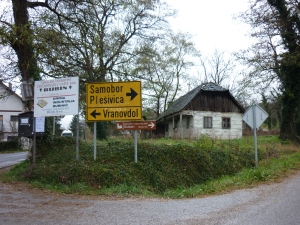
The Road Up to Plešivica
This past November, all that changed. As it happened, the exit for Jastrebarsko (or “Jasko”, as the locals call it) was as far down the highway as I would push my little rental car that day. It wasn’t to explore or linger in town (apologies to the residents and business owners) that I exited the “autocesta”. My mission was to pass through town and head up into the foothills that lie beyond its north-western edges. You see, Jastrebarsko is the natural departure point for journeys into one of Croatia’s most pretty and off-the-beaten trail wine-making regions: Plešivica.
Plešivica, technically a sub-region within the larger Continental Croatia wine-growing region, has itself five sub-regions of wine production – or as they are more aptly called, Wine-Growing Hills: Krašnić, Ozalj-Vivodina, Plešivica-Okić, Samobor, and Sveta Jana. Total area under vine is approximately 3,300 hectares (8,154 acres). I was about to have my first look at some of them.

Climbing Up to Plešivica
It was a cold and rainy autumn day as I clutched into second gear and started to climb the small road leading up into the Žumberačka Gora foothills, where some of the most important vineyards in Plešivica are located. Here the hills reach as high as 1,300 feet (400 meters) above sea level, with Alpine-styled chalet houses and family farms adorning their peaks and terraces.
One of the most striking things about this region is the way the hills form a perfectly shaped amphitheater – a sort of horseshoe of hills partially surrounding a plush, green valley. The vineyards of Plešivica cling to the best positions on the hillsides within the amphitheater.
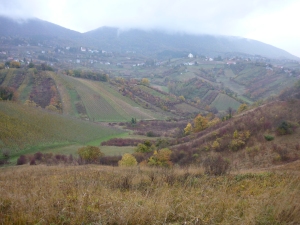
The Wine Hills of Plešivica
While the wines of Plešivica – like most of the Continental zone – are predominantly white, and most of the acreage is planted to white and blush-colored varieties (Chardonnay, Gewurztraminer, Kraljevina, Pinot Blanc, Pinot Gris, Riesling, Sauvignon Blanc, and Sylvaner), it was ultimately a red wine that brought me to these wine-growing hills: Portugieser (or “Portugizac”, as it’s called in Croatia).
You see, it was November 10th. And everyone in Croatia knows that the following day – November 11th – is St. Martin’s Day, the traditional celebration of the day when must (grape juice) turns to wine, and the new vintage is born.
Obviously a certain part of this nice myth is not 100% accurate; as you can tell, I arrived the day before St. Martin’s Day and the Portugizac must had already turned into wine. And happily it was already flowing into glasses, ready to drink.
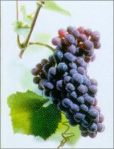
Portugieser Grapes
Portugizac is often referred to as the Croatian version of the seminal Beaujolais Nouveau from southern Burgundy in France. This is only partially true, as Velimir Korak, one of Plešivica’s most prominent winemakers, kindly explained to me.
Unlike Beaujolais Nouveau, Portugizac grapes are destemmed, crushed, and then fermented. And herein lies the difference: Beaujolais Nouveau grapes are not crushed: the whole clusters are put into an enclosed vat under controlled conditions that cause the grapes to ferment from the inside out – until they explode under the pressure of CO2 and release their partially fermented must into the tank (a method of winemaking called carbonic maceration).
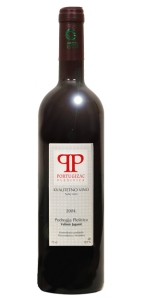 Portugizac is an unpretentious, early-drinking, light and fruity wine meant to be consumed within 6 months. It displays fresh, clean aromas and flavors that are reminiscent of black cherries and raspberries. It is a high acid, food-friendly wine with gentle, round tannins and sometimes a slightly bitter finish. Simple and friendly, sort of like Beaujolais Nouveau.
Portugizac is an unpretentious, early-drinking, light and fruity wine meant to be consumed within 6 months. It displays fresh, clean aromas and flavors that are reminiscent of black cherries and raspberries. It is a high acid, food-friendly wine with gentle, round tannins and sometimes a slightly bitter finish. Simple and friendly, sort of like Beaujolais Nouveau.
True enough, most wine aficionados and even winemakers in Croatia do not highly regard Portugizac, and it will never achieve any fame or fortune as a serious wine or arrive to great fanfare on wine shelves around the world every November. But it is firmly part of the local winemaking tradition, and come St. Martin’s day there is no other wine that seems to suit the mood of harvest time, or tastes the way the wine cellars of autumn smell from that heavenly combination of grape must, yeast, and CO2 all cracking, whispering and giggling in tank and barrel.
By the way, if you happen to travel to Croatia in autumn and want to experience a traditional treat, look for harvest and holiday fairs held in small towns in the region. It is not uncommon to find Portugizac being poured in great volume, accompanied by a newspaper cone full of freshly roasted chestnuts. It is a Charles Dickens-meets-the-Balkans experience, and it’s a scene you will remember with fondness. I know I will.
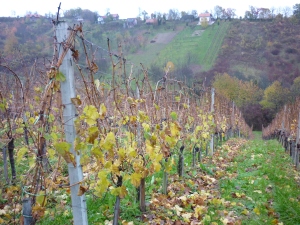
Plešivica Vineyards in the Autumn
Equally quaint and unusual in a world full of wine regions with state-of-the-art wineries and fee-based tasting rooms is the laid-back and unpretentious manner of winemakers everywhere in Croatia (more about them in later blogs). In Plešivica I was reminded of this through an unplanned and spontaneous experience: as the evening drew near and I was driving down the rain-slicked hills toward the highway that would take me back to Zagreb, I realized that I had forgotten to buy some Portugizac for my uncle down on the coast, who had requested that I smuggle him a few bottles to serve at Christmas dinner (most Portugizac is consumed locally and never reaches the further-flung reaches of Croatia).
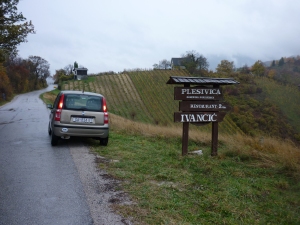 So I turned around and drove back to the Korak winery, which I had visited earlier in the day and where I knew there had to be a few bottles of Portugizac lurking.
So I turned around and drove back to the Korak winery, which I had visited earlier in the day and where I knew there had to be a few bottles of Portugizac lurking.
I knocked and Mrs. Korak answered the door. When I explained my predicament, she shook her head; they had sold the last few bottles that morning. “Wait a minute”, she said; “come with me”. I was led into the cellar, where she proceeded to look around for some empty bottles. “I think there is some left in here”, she assured me, pointing towards a small, stainless steel tank. Next thing I knew, she was filling three bottles with a funnel and sticking labels on them by hand. “Here you go”, she smiled. I reached for my wallet but she waved me away with her hand. “Don’t be silly”, she dismissed.
Wow. At that moment I knew that never again could I mindlessly speed past the exit for Jastrebarsko and not remember – and revisit – the stunningly beautiful hills of Plešivica. In fact, taking the exit could very well become a pleasant new pastime, just like drinking Portugizac and eating chestnuts from a newspaper cone in autumn.
 Ah, the things you discover and experience when you have a rare occasion to change course, stop a moment, and forget where you were going in the first place….
Ah, the things you discover and experience when you have a rare occasion to change course, stop a moment, and forget where you were going in the first place….
Those kinds of discoveries can alter your road map forever. It’s when life grows sweeter – and the must of old habits turns into the new wine of celebration.
(Next time: meet two of Plešivica’s winemakers and learn about the delicious mystery buried in the ground at one winery)
No comments:
Post a Comment